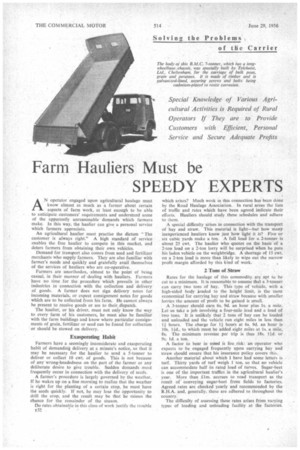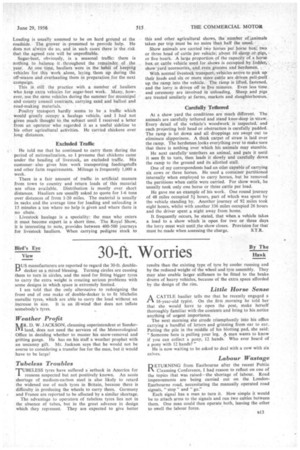Farm Hauliers Must be
Page 92

Page 99

If you've noticed an error in this article please click here to report it so we can fix it.
SPEEDY EXPERTS
AN operator engaged upon agricultural haulage must know almost as much as a farmer about certain aspects of farm work, at least enough to be able. to anticipate customers' requirements and understand some of the apparently unreasonable demands which farmers make. In this way, the haulier can give a personal service which farmers appreciate.
An agricultural haulier must practise the dictum "The customer is always right." A high standard of service enables the free haulier to compete in this market, and deters farmers from obtaining their own vehicles.
Demand for transport also comes from seed and fertilizer merchants who supply farmers. They are also familiar with farmer's needs and quickly and gratefully avail themselves of the services of hauliers who are co-operative_
Farmers are unorthodox, almost to the point of being casual, in their manner of -dealing with hauliers. Farmers have no time for the procedure which prevails in other industries in connection with the collection and delivery of goods. A farmer does not sign delivery notes for incoming materials, or expect consignment notes for goods which are to be collected from his farm. He cannot always be present to receive goods or see to their. dispatch.
The haulier, or his driver, must not only know the way to every farm of his customers, he must also be familiar with the farm buildings and know where particular consignments of grain, fertilizer or seed can be found for collection or should be stowed on delivery.
Exasperating Habit
Farmers have a seemingly inconsiderate and exasperating habit of demanding delivery, at a minute's notice, so that it may be necessary for the haulier to send a 5-tonner to deliver or collect 10 cwt. of goods. This is not because of any wrong-headedness on the part of the farmer or any deliberate desire to give trouble. Sudden demands most frequently occur in connection with the delivery of seeds.
A farmer's procedure is largely governed by the weather. If he wakes up on a fine morning to realize that the weather is right for the planting of a certain crop, he must have the seeds quickly. If not, he may lose the opportunity to drill the crop, and the result may he that he misses the chance for the remainder of the season.
Do rates obtainable in this class of work justify the trouble Er
• which arises? Much work in this connection has been done by the Road Haulage Association. In rural areas the lists of traffic and rates which have been agreed indicate their efforts. Hauliers should study these schedules and adhere to them.
A special difficulty arises in connection with the transport of hay and straw. This material is light—but how many inexperienced hauliers know just how light it is? Five or six cubic yards make a ton. A full load for a 2-tonner is about 25 eWt. The haulier who quotes on the basis of a 2-ton load on a 2-ton lorry will he surprised when he puts his laden vehicle on the weighbridge. A shortage of 15 cwt. on a 2-ton load is more than likely to wipe out the narrow profit margin afforded by this kind of work.
2-Tons of Straw Rates for the haulage of this commodity are apt to be cut to a minimum. It is reasonable to assume thal a 3-tonner can carry two tons of hay. This type of vehicle, with a high-sided body loaded to the height limit, is the most economical for carrying hay and straw because with smaller lorries the amount of profit to be gained is small.
A 3-tonner should earn 6s. 9d. an hour plus is. a mile. Let us take a job involving a four-mile lead and a load of two tons. It is unlikely that 2 tons of hay can be loaded and unloaded and the vehicle run eight miles in less than 1i hours. The charge for II hours at 6s. 9d. an hour is 10s. lid., to which must be added eight miles at Is. a mile, 8s. The minimum revenue per trip is thus 18s. 14.d. or 9s. Id. a ton.
A factor to bear in mind is fire risk: an operator who expects to be engaged frequently upon carrying hay and straw should ensure that his insurance policy covers this.
Another material about which I have had some letters is turf. Thirty yards of turf weigh I ton, so that no vehicle can accommodate half its rated load of turves. Sugar-beet is one of the important traffics in the agricultural haulier's year. More than Lim. accrues to road transport as the result of ' conveying sugar-beet from fields to factories. Agreed rates are checked yearly and recommended by the R.H.A. and, generally, these are adhered to throughout the country_ The difficulty of assessing these rates arises from varying types of loading and unloading facility at the factories. Loading is usually assumed to be on hard ground at the roadside. The grower is presumed to provide help. He does not always do so, and in such cases there is the risk that the agreed rate will be unprofitable.
Sugar-beet, obviously, is a seasonal traffic: there is nothing to balance it throughout the remainder of the year. At one time, hauliers were in the habit of keeping vehicles for this work alone, laying them up during the off-season and overhauling them in preparation for the next campaign.
This is still the practice with a number of hauliers who keep extra vehicles for sugar-beet work. Many, however, use the same vehicles during the summer for municipal and county council contracts, carrying sand and ballast and road-making materials.
Poultry transport hardly seems to be a traffic which would greatly occupy a haulage vehicle, and I had not given much thought to the subject until I received a letter from an operator who regarded it as a useful sideline to his other agricultural activities. He carried chickens over long distances.
Excluded Traffic He told me that he continued to carry them during the period of nationalization, so I presume that chickens came under the heading of livestock, an excluded traffic. His customer, also gives him work transporting feedingstuffs and other farm requirements. Mileage is frequently 1,000 a week.
There is a fair amount of traffic in artificial manure from town to country and return loads of this material are often available. Distribution is mostly over short distances. Hauliers are usuallY asked .to quote for 1-6 tons over distances of from 1-20 miles. The material is usually in sacks and the average time for loading and unloading is 15 minutes a ton where no help is given and where there is no chute.
Livestock haulage is a speciality: the man who enters it must become expert in a short time. The Royal Show, it is interesting to note, provides between 400-500 journeys for livestock hauliers. When carrying pedigree stock to this and other agricultural shows, the number of ',animals taken per trip must be no more Than half the usual. . • .
Show animals are carried two horses per horse box; two or three head of cattle per vehicle; about id sheep or pigs, or five boars. A large proportion of the capacity of a horse box or cattle vehicle used for shows is occupied by fodder,show yard accessories, and even grooms and herdsmen.
With normal livestock transport, vehicles arrive to pick up their loads and six or more store cattle are driven pell-pell up the ramp into the vehicle. The ramp is lifted, fastened, and the lorry is driven off in five minutes. Even less time. and ceremony are involved in unloading. Sheep and pigs are treated similarly at farms, markets and slaughterhouses.
Carefully Tethered
At a show yard the conditions are much different. The animals are carefully tethered and stand knee-deep in straw. Every detail of the vehicle's woodwork is inspected, and each projecting bolt head or obstruction is carefully padded. The ramp is let down and all droppings are swept out to eliminate slipperiness. A thick carpet of straw is laid over the ramp. The herdsman looks everything over to make sure that there is nothing over which his animals may stumble.
He next carefully untethers an animal, and pats it until it sees fit to turn, then leads it slowly and carefully down the ramp to the ground and its allotted stall.
One of my correspondents had an oiler capable of carrying six cows or three horses. He used a container partitioned internally when employed to carry horses, but he removed the partitions when cattle were carried. For show work, he usually took only one horse or three cattle per load.
He gave me an example of his work. One round journey of 48 miles occupied 51 hours, part of which was spent by the vehicle standing by. Another journey of 92 miles took eight hours, whilst with another 336 miles occupied 26 hours and the driver spent a night away from home.
It frequently occurs, he stated, that when a vehicle takes a load to a show which is open for two or three days the lorry must wait until the show closes. Provision for that must be made when assessing the charge. S.T.R.
















































































































































